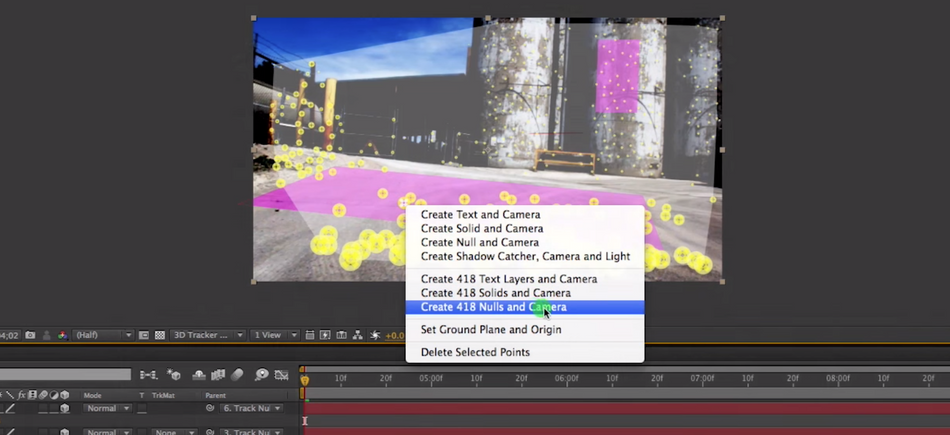How To Add Video Background In C4d
Want to motility your projects between Cinema 4D and After Effects?
I'chiliad always amazed at the number of people that don't realize that Cinema 4D and Subsequently Effects integrate really well with each other. Despite beingness adult by two different companies (Adobe and Maxon), C4D and After Furnishings have some pretty deep integrations that brand them play really well together.
In this commodity, we are going to discuss how to take advantage of this amazing workflow betwixt Subsequently Effects and Movie house 4D.
Why Should I Move Between Cinema 4D and Later on Effects?
Great question! Well the brusque answer is there are a LOT of reasons why you might want to link Movie house 4D and After Effects together, but here are a few of our favs:
- Y'all tin can utilize the power of the mograph module in Picture palace 4D for complex and powerful animations inside Subsequently Effects.
- Calculation 3D elements to your explainer video. Maybe a robot???
- Adding 3D Photorealistic content to your tracked footage.
- Using Cinema 4D for dynamics, only Later on Effects for creating shapes and textures.
This commodity will take a await at these unlike workflows and give you a step-by-step process to follow along. So without further ado, here's our start instance.
1. Using Cinema 4D's Mograph Inside Later on Effects

Between Cloners, Fractures, Tracers, and Effectors the MoGraph module in Cinema 4D is an indispensable tool to use on your projects.
Once y'all fix your Cinema 4D scene, just import that Cinema 4D project into your Subsequently Furnishings project (did you know it was that easy?), and drag the project onto your timeline.

In the effects panel of your Cinema 4D layer, change the renderer to Standard (either Draft or Terminal, merely make sure you lot use Final when you finish), and set up the camera to your "comp camera."

Add a camera and a null to control it, and center your composition!

Any changes you make in Movie house 4D volition automatically update within your After Effects project. You can add together whatever effects, masks, blitheness, etc. to that Cinema 4D layer like you would anything else.
2. Adding 3D Elements to Your Explainer Videos

I know, everyone loves robots, equally do I. Here, I created my robot with basic shapes and a little rigging. EJ Hassenfratz covered a lot on this topic in Modeling Rubberhose Fashion Characters in Cinema 4D.
In this case, I did the same thing as before, except used Cinema 4D'southward camera instead of the "comp camera."

The background is just a solid colour inside After Furnishings. That shadow? It's merely a disc within Cinema 4D, with a blackness fabric and the transparency at 98%.



In one case you add the disc to your scene, position it under the robot, add a "PSR" constraint, bank check "maintain original," and finally un-check "rotation." That way, the robot is afflicted by the position, not the rotation.
Confused? Just follow the GIFs beneath.



Yay for robots! Now all yous have to do is import that sucker into Subsequently Effects.
3. Add together 3D Photorealistic Picture palace 4D Content to Your Tracked Footage in After Furnishings
This has been covered in many, many tutorials, and the workflow hasn't changed much in the past few years. Sean Frangella did a great, 2 part in-depth tutorial on the workflow hither. Any problems y'all might encounter or questions you might have should be answered there.
Sort of know the workflow but demand a refresher? Here are the basic steps (screens shots are directly from the tutorial).
1. Rail footage with 3D Camera Tracker (surprise, surprise).

2. Select your nulls, correct click, and "Create Nulls From Camera"

three. With your composition selected, go to File > Export > MAXON CINEMA 4D Exporter

four. The export is at present a .c4d file. Open up that in Movie theater and, viola! Your scene with all your nulls is in there ready to go.

v. Add geometry to the scene. You can use the nulls position data to line information technology up.

6. Open that same .c4d file inside of Later Furnishings and drag information technology to your timeline, just similar before.

There ya go! 3D, within of Later Effects, tracked to your scene.
Annihilation you do inside of Cinema 4D (lighting, texturing, modeling, return settings, etc.) will update automatically inside of Afterwards Effects.
Function two of Sean Frangella'due south tutorial goes into detail about creating and adjusting lights, textures, and render settings to blend 3D with your alive footage.
iv. Using Cinema 4D for Dynamics, but Using Subsequently Effects to Create Shapes and Textures
Lasse Clausen made this awesome script that takes nulls from Movie house 4D, and pops them correct into your After Furnishings composition!
What does this mean???????
Well, right off the bat, you can run simulations of wind, gravity, etc, and attach your shape layers to the nulls that Cinema 4D creates, in merely 1 click! (Yeah, you read that correct...)

Head over to the AEC4D page and watch the tutorial to meet other situations where this tin be used.
STILL FEELING OVERWHELMED?
No problem, we've got you covered.
- I accept a fun, brusk, and simple slideshow that you can download (for free). If you need someone to take 10 minutes and evidence y'all the basics of 3D, terms, and workflows, get it here.
- If you're more of an eBook person there's as well a complete 2D/3D Motion Design Lexicon PDF here on School of Motion
- Want to go from null to 3D ninja using Cinema 4D? Bank check out our Cinema 4D Basecamp Course.
How To Add Video Background In C4d,
Source: https://www.schoolofmotion.com/blog/cinema-4d-to-after-effects
Posted by: joneslessed.blogspot.com


0 Response to "How To Add Video Background In C4d"
Post a Comment